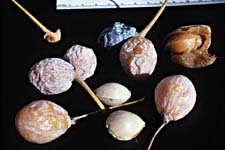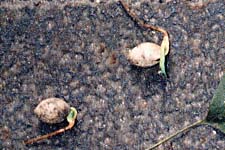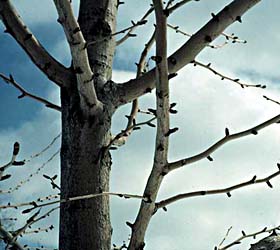







Ginkgo trees are dioecious, which means that the male and female reproductive organs are found on different trees. The sperm, which is transported inside a pollen grain by the wind, is dispersed in the spring.
One of the ginkgo's more interesting characteristics is that its sperm are motile (have flagellae), a trait found only in ginkgo and cycads among living seed plants. The pollen grains, which contain the sperm, are found in clusters attached to short shoots coming off the branches of the tree. In the spring these clusters open up and the pollen grains are carried away by the wind until they land upon a female ovule. It then pollinates the seed, but the actual fertilization of the seed does not occur until the fall, usually after the seed has fallen off the tree and the fleshy seed coat has rotted away.
 |
 |
Seeds and Seedlings : On the left, a collection of ripe seeds, showing the fleshy yellow seed coat as well as seeds with the coat stripped away. On the right are sprouting seedlings photographed at the Botanical Garden in Budapest.
Ginkgo seeds consist of a woody inner "nut", surrounded by a fleshy, yellow coat; the seeds resemble yellow cherries. They fall off of the parent tree in the fall just before the leaves. The seeds are relatively large in comparison to the seeds of most other trees (especially conifers). Once the seeds fall off the tree in autumn and become fertilized, they can be dispersed by animals in order to distribute the species. One of the ginkgo's main dispersers is the gray squirrel. This dispersal allows the seeds to be transported someplace where there may be less competition for light or other resources.
While Ginkgo biloba is a hardy tree, it prefers areas with a distinct seasonality and moderate rainfall, such as Mediterranean climates with wet winters and hot summers. When conditions are favorable, the ginkgo can grow over 30 cm per year for the first 30 years of its life. It has another unique characteristic that it can grow steadily in the shady understory of a forest until there is a light gap. At this point, it can quickly grow tall and become a dominant tree. Ginkgoes are also highly resistant to damage from pollution, fungi or pests. All of these characteristics probably contribute to its long life span, sometimes up to 1000 years!
 |
 |
Short shoots to trees : You can see the knob-like short shoots of Ginkgo in the picture at left. Ginkgoes are deciduous, dropping their leaves in winter. The tree at right is pictured with its full complement of leaves in late spring.
It is odd that, while ginkgoes are such hardy trees, they would most likely be extinct now had it not been for the Buddhist monks in northern China. Ginkgoes were cultivated by monks in temples partly due to their medicinal value, their edible seeds, and probably for their beauty. While Ginkgoes went extinct in the wild, they thrived in the courtyards of the monks. This is why we are still able to enjoy this tree today. It is a great asset to any city planner, due to its resistance to pests and pollution. It can now be found in cities all over the world.

Del Tredici, P. 1989. Ginkgos and multituberculates: evolutionary interactions in the Tertiary. BioSystems v. 21-22:327-337.
Sun, G. 1993. Ginkgo coriacea Florin from lower Cretaceous of Houlinhe, Northeastern Nei Monggol, China. Paleontographica. 230:159-168.

